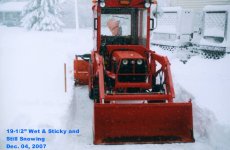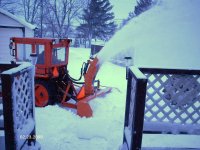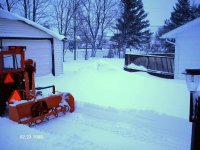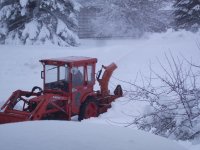I would think the power requirments would be dependent on the density of the snow, the throughput (the depth of snow x the width of the blower x the speed of the machine~cu ft /sec), and the tip speed of the blower at 540 or 1000 rpm of the pto drive. Once you fix the width of the machine, you can't control the density of the snow but you can control the machine speed and to some extent under certain conditions you can vary the tip speed if the density and depth are not too great. You can also take half cuts once you've cut a swath to get started or raise the blower to reduce the throughput and make multiple passes. It goes without saying that the throughput has to be matched to the blower's ability to handle the snow and that's determined by trail and error. I plan on setting the pto speed to 540 rpm (1800 engine rpm) and seeing if low reverse speed allows the blower to handle the snow at full width and depth.
I have a 7 foot dual auger ARPS blower that I will be using for the first time this winter. The factory recomends that it be used on tractors with 50 to 80 hp, so that's roughly 7 to 11 hp required per foot of width.
I generally can keep up with normal snows around here with a back blade but that fails when we get wind drifted snow. (We get up to two feet at a time and I'd start blowing when it got to 6-8 inches and then just keep up as required. Our snow is generally pretty dry except when the chinooks start to blow. then it starts out real fine and as the temperature rises it starts to get wet.) I'm hoping to use our Ford 4610 to do the clearing but if I have to, I can switch to the TD95D. I'm hoping to use the TD95D to spin feed large round bales to the cows . It has a cab and it will be nice to have a warm cab to feed with. But if I have to, I can feed with the open station 4610 and use the TDD to blow snow. I don't think it will come to that, however unless we have one of those 100 year winters.(Knock on wood!)
This is my first time using a snowblower so I'm sure I will learn a whole bunch about the process via trail and error. I just hope the errors are small ones.
====================================================================================================================================================================================================
As it is that time of year again it will not hurt to talk about the speed of travel for a snow caster and its motive power.
The snow caster implement is totally dependent upon-
1. the implement carriers total horse power.
2. the rated horsepower of the power take off for the implement carrier
at the 540 or 1,000 RPM engine speed setting.
3. The rated gearbox horsepower rating for the snow caster implement..
I am familiar with the Chinook winds which batter Stevens Pass in The State of Washington, but I was not aware that they traveled as far inland as your location.
Being strictly dependent on temperature a fresh snow fall can weigh as little as 21 pounds per cubic foot and with freeze/thaw cycles the weight can more than double over time.
The two stage snow caster is totally dependent upon the impeller for its work as the the implement carrier is forcing the snow into the cross auger(s) which conveys the snow to the center of the snow caster where it is forced into the impeller housing strictly with the forward or reverse movement of the implement carrier.
The size of the impeller and the number of paddles in the impeller are what as Kenny Cartman would say "kicks A**" and is the business end of things.
Dependent upon the builder of the snow caster the impeller drum is dependent upon- 1., the number of impeller paddles and thier curvature within the impeller drum if applicable as a curved impeller reduces the amount of snow the snow caster can dispose of and 2., the rotation speed of the impeller at the 540 or 1,000
R.P.M., P.T.O., speed of the implement carrier at the rated engine speed of the for the Power Take Off in the front or rear but I will be using the 540 R.P.M., speed for reference.
In Pronovost's case(yes it is a shameless plug) their snow casters will have four or five or six impeller paddles and the impeller paddles are straight and slightly curved on the exterior edge and have been formed to create a cupping form to carry snow more efficiently to reduce spillage to a minimum(another shameless plug for Pronovost).
The larger the impeller drum in diameter and depth the greater amount of snow can be cast per rotation of the impeller paddles times either 540 or 1,000 revolutions.
Every snow caster will plug and shear pins if the implement carrier is traveling to fast!!!!!
If you travel at three miles per hour you are traveling at 264 feet per minute.
If you have one foot of snow to remove and the snow caster is 7 feet wide you have 147 pounds of snow entering the snow caster each second and 40,000 pounds per minute of snow (rounded higher) entering the impeller and the impeller must be running at its optimum speed(rated P.T.O., engine speed) to to cast the snow away. In the example the snow caster must have the torque to remove 667 pounds per second of the snow fall to keep up.
If you travel at one mile per hour ( I know, boring!!!!) you are only traveling at 88 feet per minute and requiring the snow caster to remove 13,000 pounds (rounded higher)(per minute of snowfall(big snooze, I know) The snow will be cast further and you will have no issues with snow banks. Just like fitting ground it takes time.




